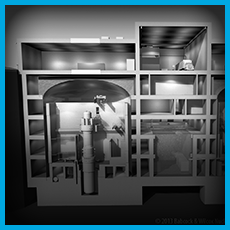OVERVIEW
Nuclear power provides a low-cost, greenhouse gas-free electric power source the U.S. and the world needs to combat climate change. But high construction costs, security and safety concerns,1 and difficulty competing in certain markets has threatened the competitiveness of part of our existing fleet.2 Some firms, seeing an opportunity to address these challenges and offer further improvements, are seeking to commercialize the next generation of nuclear technologies. These new reactors are designed to make nuclear power generation safer3 and greatly reduce construction costs.4 In addition, they come in variety of sizes, so the customer can pick the right technology for the right situation.5 Some even offer a solution to nuclear waste storage.6 The technologies include small modular reactors (SMRs) — in some cases scaled down versions of large reactors7 and in others more innovative reactor designs — and even more advanced concepts that use different fuels or cooling systems.8 Although these technologies show enormous potential, they will require years of dedicated federal support — for research, testing, and Nuclear Regulatory Commission (NRC) licensing — to reach commercialization.
ANALYSIS
While SMRs are moving towards licensing and demonstrations within the coming decade, more advanced nuclear technologies are further from commercialization. As such, the two categories confront different policy issues.
Small Modular Reactors
SMRs are closer to commercialization, with the first plant likely to come online in the 2020s.9 Each produces less than a third the electricity of a conventional light water reactor plant and can be combined in modular fashion to match the needs of the customers they serve. One individual SMR could power 42,000 to 125,000 homes.10
The precise costs of operating the first SMRs depend partially on decisions the NRC has yet to make. The current regulatory system sets fixed financial obligations — annual fees for the NRC,11 insurance premium payments,12 and decommissioning funds13 — with a one-size-fits-all approach geared toward today’s large reactors. Because SMRs challenge the assumption that a nuclear fleet is only composed of large-scale reactors, the NRC must decide whether they warrant changes in obligations. In addition, SMR manufacturers explain that underground siting enhances safety and security.14 This may justify reduced personnel requirements and siting on smaller plots of land — old coal plants that cover half the size of the National Mall, not the eight National Malls required for a large nuclear plant.15
The cost competitiveness of SMRs also depends on construction and financing costs. While the first SMR plant of its kind will be more expensive than subsequent units, estimates put the cost of multi-module SMR plants between $2 and $3 billion dollars.16 This is far less than the $7 billion for a full-scale reactor,17 which is about twice the size of an SMR. Manufacturing components off-site and shipping these to location via rail, truck, or barge should streamline the construction process, preventing cost overruns.18 Moreover, efficiencies of scale make it cheaper to add additional units to a site after the first unit is built.
Advanced Nuclear Technologies
More advanced reactors address the safety, cost effectiveness, and environmental sustainability concerns of nuclear energy. Today’s reactors use water as a coolant and fresh uranium as fuel. New designs use a variety of coolants and fuels. The coolants include high temperature gas, molten salt, lead, and sodium. For fuel, many new technologies are able to reuse spent nuclear fuel currently stored as waste, thereby helping to solve two problems at once.19 The U.S. does not currently reprocess and reuse fuel,20 but the practice is common in France, Japan and elsewhere.21
Although more advanced nuclear technologies are highly varied, several companies plan to lower construction costs by manufacturing components off-site and shipping to location (as with SMRs). They too will be highly affected by NRC decisions whether or not to shift to a technology independent regulatory regime.
IMPLEMENTATION
Congress, DOE and the NRC must work together to ensure the great potential for advanced nuclear comes to fruition.






